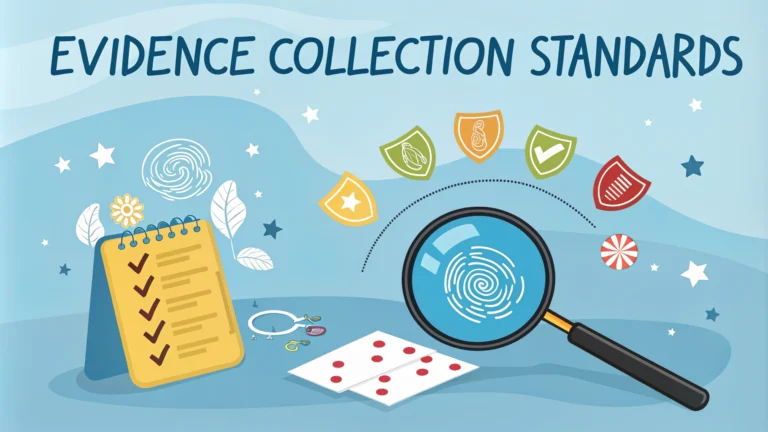Evidence collection during penetration testing requires careful documentation and preservation of findings to maintain legal and operational integrity.
Professional pentesters must follow strict procedures to ensure their evidence holds up to scrutiny and can be used for compliance requirements or potential legal proceedings.
This guide outlines the key standards and best practices for gathering, documenting, and storing evidence during security assessments.
Types of Evidence to Collect
- Network traffic captures (PCAP files)
- System logs and event records
- Screenshots of vulnerability confirmations
- Command outputs and tool results
- Web application responses
- Database query results
Documentation Standards
Each finding must include timestamps, specific systems affected, and detailed reproduction steps.
- Date and time of discovery
- Tools used and their versions
- Environmental conditions
- Target system information
- Impact assessment
Evidence Handling Guidelines
Maintain a clear chain of custody for all collected evidence.
- Use write-protected storage devices
- Create SHA256 hashes of evidence files
- Store multiple backup copies
- Encrypt sensitive data
- Document who accessed the evidence and when
Tools for Evidence Collection
- Screen Capture: Greenshot, ShareX
- Packet Capture: Wireshark, tcpdump
- Log Collection: ELK Stack, Splunk
- Documentation: Dradis, PlexTrac
Storage and Retention
- Use encrypted containers (VeraCrypt recommended)
- Implement backup systems with redundancy
- Follow client-specified retention periods
- Store evidence in compliance with data protection regulations
Legal Considerations
Evidence collection must comply with local and international laws regarding data privacy and computer access.
- Obtain written permission before testing
- Stay within scope boundaries
- Respect data protection regulations
- Document authorization levels
Reporting Standards
| Element | Required Information |
|---|---|
| Finding Details | Description, impact, risk level |
| Technical Evidence | Screenshots, logs, network captures |
| Remediation | Step-by-step fix instructions |
Moving Forward with Evidence Management
Implement a systematic approach to evidence collection and management from the start of each engagement.
- Create evidence collection templates
- Train team members on proper procedures
- Regular review of collection methods
- Update tools and processes as needed
Contact professional organizations like SANS (www.sans.org) or OWASP (www.owasp.org) for additional guidance on evidence collection standards.
Quality Control Measures
Establishing quality control procedures ensures evidence reliability and consistency across assessments.
- Peer review of collected evidence
- Validation of tool outputs
- Cross-reference multiple data sources
- Regular calibration of testing tools
Incident Response Integration
Evidence collection procedures should align with incident response capabilities.
- Coordinate with IR teams
- Share relevant findings immediately
- Maintain communication channels
- Document incident triggers
Immediate Response Requirements
- Critical vulnerability protocols
- Escalation procedures
- Emergency contact information
- Response time standards
Continuous Improvement Process
Regular evaluation and updates to evidence collection methodologies ensure effectiveness.
- Collect feedback from stakeholders
- Monitor industry standards
- Update documentation templates
- Enhance automation capabilities
Building a Sustainable Evidence Framework
Success in penetration testing evidence collection relies on consistent application of standards and adaptation to emerging threats.
- Establish clear policies and procedures
- Maintain current tool sets and methodologies
- Foster collaboration between security teams
- Invest in ongoing training and certification
- Regular review and enhancement of processes
FAQs
- What are the key principles of evidence collection during penetration testing?
Evidence must be collected in a forensically sound manner, maintaining chain of custody, ensuring data integrity, using write blockers when necessary, and documenting all actions taken during collection. - How should screenshots be properly captured during penetration testing?
Screenshots should include timestamps, terminal outputs, and full window captures. They should be saved in their original format with metadata intact and accompanied by detailed notes about the context and actions performed. - What documentation is required when collecting evidence during a penetration test?
Required documentation includes detailed logs, timestamps of activities, tools used, commands executed, system responses, discovered vulnerabilities, and methods of exploitation, all maintained in a chronological order. - How should sensitive data be handled during evidence collection?
Sensitive data must be encrypted during storage and transmission, access should be restricted to authorized personnel only, and proper data handling procedures as specified in the penetration testing agreement must be followed. - What tools are considered standard for evidence collection in penetration testing?
Standard tools include packet capture software (Wireshark), screen recording tools, logging utilities, forensic imaging tools, and automated documentation platforms that maintain evidence integrity. - How long should evidence from penetration tests be retained?
Evidence retention periods should align with client requirements, legal obligations, and industry standards, typically ranging from 6 months to 7 years, with sensitive data being securely destroyed after the retention period. - What should be included in the chain of custody documentation?
Chain of custody documentation must include who collected the evidence, when it was collected, where it was stored, who had access to it, and any transfers or handling of the evidence, with signatures and timestamps for each transfer. - How should network traffic captures be handled during evidence collection?
Network captures should be collected using appropriate tools, filtered to exclude irrelevant traffic, stored in standard formats (like PCAP), and handled in accordance with privacy regulations and client agreements. - What are the legal considerations when collecting evidence during penetration testing?
Legal considerations include obtaining proper authorization, respecting privacy laws, adhering to data protection regulations, maintaining confidentiality, and ensuring compliance with relevant industry standards and jurisdictional requirements. - How should evidence of successful exploitation be documented?
Evidence of successful exploitation should include detailed step-by-step documentation, proof of concept code, impact assessment, affected systems, and mitigation recommendations, all properly timestamped and documented.







